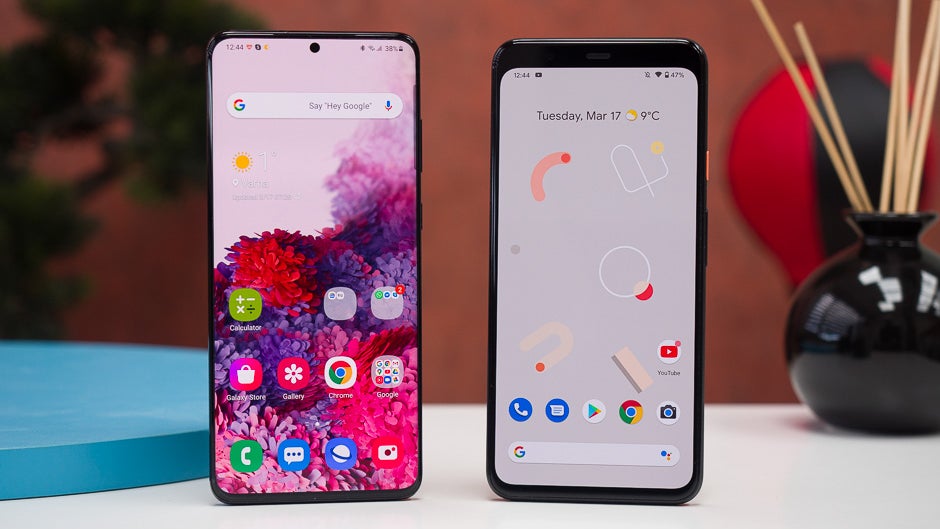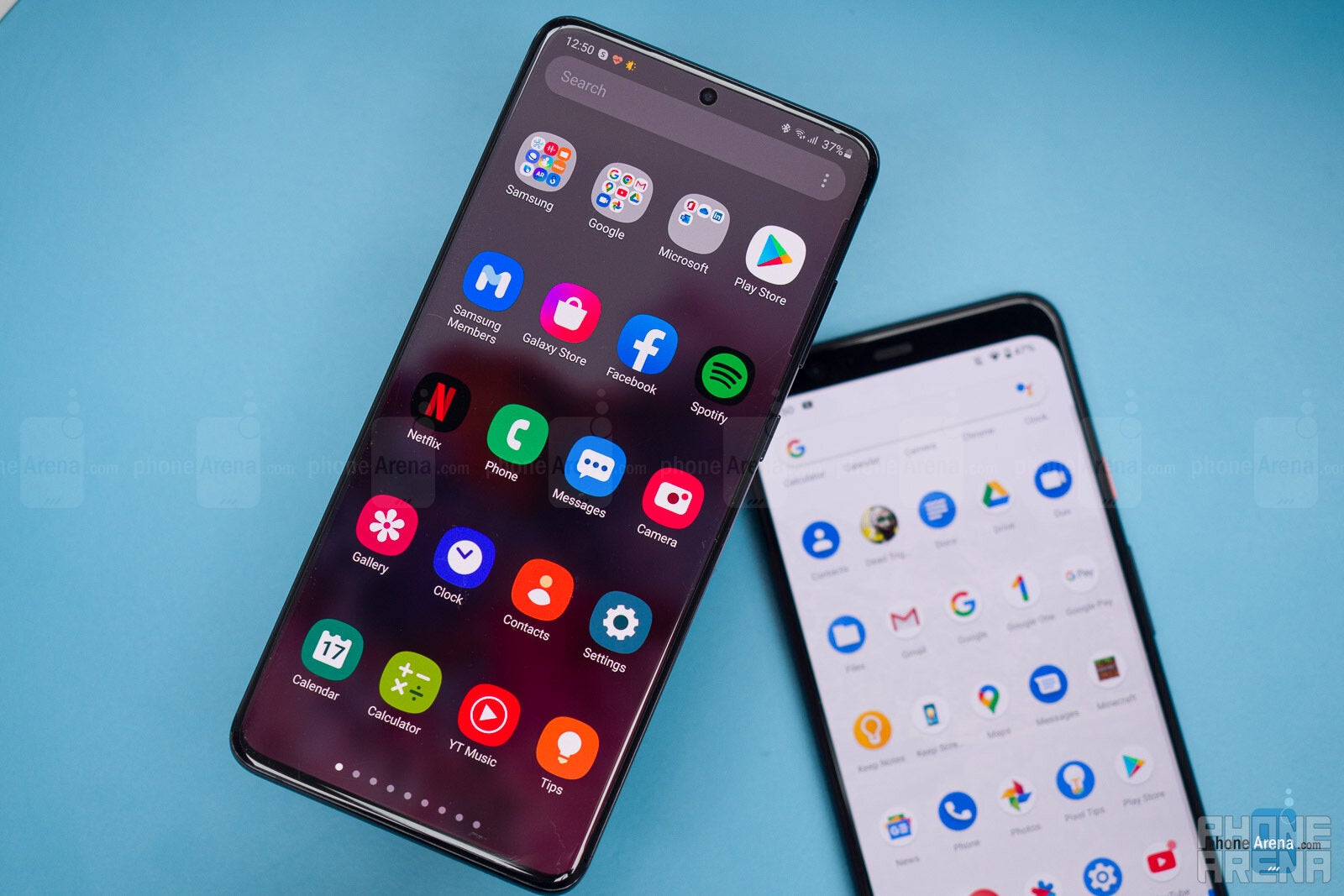Samsung Galaxy S20 Plus vs Google Pixel 4 XL
We may earn a commission if you make a purchase from the links on this page.

The Galaxy S21 is now joining the premium phones market, and the Pixel 5 has also been released by Google. If you want to know more about these two newer pones, check out our detailed comparison of the Galaxy S21 vs Google Pixel 5!
##
Summary
Although the Galaxy S20 Ultra is the crown jewel among Samsung’s latest flagship phone crop, it’s the Galaxy S20 and S20 Plus that will end up inside more pockets. The reason is pretty trivial - they are more affordable than the S20 Ultra and are very likely to be more popular than the $1,399 flagship.
One of the phones that seem like a direct rival to the S20 Plus is Google’s Pixel 4 XL flagship which is much more affordable. It was launched at $899 for the 64GB version and often dips well below that price, making it an often-overlooked alternative.
Needless to say, the Galaxy S20 Plus is a much more future-proof device. It has better hardware and supports the up-and-coming 5G data standard. It also has a much more versatile camera, and overall, seems like the more sensible purchase at this point, even despite the higher price.
Buy Samsung Galaxy S20 Plus from:
Design & display
Both phones have similar yet distinct design languages. Glass is the main material of choice on both the S20 Plus and the Pixel 4 XL, but both devices also employ lightweight aluminum frames to keep the weight down. Meanwhile, the S20 Plus is the very definition of a fingerprint magnet due to the glossy glass Samsung uses.
In terms of size, the S20 Plus is a much more manageable device than the Galaxy S20 Ultra. The S20 Plus and the Pixel 4 XL are extremely similar in terms of overall size, though Google’s flagship is wider, thicker, and slightly heavier. You’re unlikely to notice any significant difference in real life, though.
Unlike the Galaxy S20+, the Pixel 4 Xl relies on a more conservative design with a larger top bezel that doesn’t look as exciting. However, it’s chock-full with sensors that aid specific phone features and functionalities, including the 3D face unlock, so we are not really complaining.
The design of the Galaxy S20 Plus has way slimmer bezels, and what’s more important, the curved displays of old are all but depreciated. The curved edges on the Galaxy S20 series are pretty much non-existent.
Speaking of displays, both phones employ OLED displays, but the 6.3” display of the Pixel 4 XL can’t really hold a candle to the 6.7” Galaxy S20 Plus. In terms of size, brightness, and color reproduction, the screen on the Samsung flagship phone is superior to the Pixel’s.
Camera & audio
The Galaxy S20 Plus employs a triple-camera setup and has a ToF sensor to aid its depth-perceiving abilities, whereas the Pixel 4 XL comes forth with a dual-camera setup, consisting of a regular camera and telephoto cam with 2x zoom. The difference here is that the Galaxy S20 Plus gives you broader versatility as it can cover anything from ultra wide-angle to 30X hybrid zoom in usable increments, whereas the Pixel 4 “only” allows up to 8X hybrid zoom. If bragging rights are your thing, then the S20 Plus is the phone for you, but beware - you won’t be capturing photography masterpieces at either 8X or 30X zoom, no matter the phone.
Regular photos in broad daylight are extremely similar on both phones, with similar good color rendition, excellent dynamic range, and tons of details. In terms of general photo quality, you will be hard-pressed to find better phones on the Android scene right now. At 8X magnification, the Pixel 4 XL’s maximum, it stands its ground against the Galaxy S20 and even produces a more vibrant and eye-catchy image.
Portraits taken with the phones are pleasing, but some separation artifacts can be observed on both the Pixel and the Samsung. The Pixel produces warmer portraits that look more gritty thanks to the enhanced sharpness and contrast. Meanwhile, portraits taken with the Galaxy S20 Plus maintain a more natural stance.
Both phones produce great selfies but take different approaches. The Pixel would create grittier and more realistic selfies, whereas the Samsung flagship would favor a bit of smoothing and ironing out your skin imperfections. The Galaxy S20 Plus often exhibits a bug that randomly blurs parts of the picture that are not supposed to be blurred. We observed this issue on all three of our Galaxy S20 units, which is a bummer and would most likely be fixed with an update in the future.
Software and performance
Both devices come with Android 10 on deck, though the experience is very different on both devices. For one, the Pixel 4 XL relies on a more minimalistic approach to Android and a holistic co-existence with the Google Assistant, whereas Samsung supplies many more software features and functionalities to the Galaxy S20 Plus. The Pixel 4 XL employs a hefty amount of motion gestures that take a bit to master and arguably don’t add that much to the overall functionality of the device anyway.

In terms of biometric security, the Galaxy S20 Plus comes with a ultrasonic fingerprint scanner, while the Pixel 4 XL doesn’t. The latter opts for a pretty fast three-dimensional face unlock method, which is more secure than the standard picture-based unlock method that most flagships use these days. Coincidentally, that’s an option on the S20 Plus as well, and while it might not be that secure, it strikes the perfect balance between convenience and speed.
On the topic of performance, neither device is likely to disappoint you. While the S20 Plus comes with either the Snapdragon 865 or Exynos 990 depending on the region, the Pixel 4 XL relies on Qualcomm’s last-year Snapdragon 855 chipset which is slower in theory. The difference in performance isn’t that big, and both devices perform similarly in day-to-day tasks.
Battery life
On the Galaxy S20 Plus, there’s a rather big spread between the 60 and 120Hz display settings in terms of battery life. While in the traditional 60Hz refresh rate mode, the S20 Plus drains its 4,500mAh battery in 12 hours and 40 minutes in our custom browsing test, the newer 120Hz setting does the same exercise in around 8 hours and 23 minutes. It is certain then - battery life is the price you have to pay for the smoother display.
Meanwhile, the Pixel 4 XL achieves a much humbler result of 8 hours and 32 minutes with its display in the default 60Hz refresh rate.
Charging is fast on both devices, but the S20 Plus easily takes the cake here. It takes the S20 Plus just 66 minutes to go from 0% to 100% thanks to the ultra-fast 25W charger that Samsung has supplied in the Galaxy S20 Plus box.
Follow us on Google News



















Things that are NOT allowed:
To help keep our community safe and free from spam, we apply temporary limits to newly created accounts: